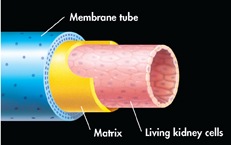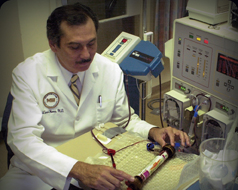Technology & Biology
Bioartificial Kidneys
Hundreds of thousands of people suffer from kidney failure. Kidneys eliminate wastes from blood while retaining vital compounds, so if your kidneys fail, you can die, poisoned by your own nitrogenous wastes. Because kidney function is so important, researchers are always working on better replacements for it.
Today's techniques save lives but are far from ideal. Techniques such as artificial kidney dialysis pass a patient's blood through a system of extremely fine tubes that retain blood cells and vital proteins while filtering out wastes, which are discarded. But important compounds are also filtered out, and they must be given back to the patient intravenously.
A technique invented by Dr. H. David Humes at the University of Michigan could eliminate this drawback. It combines the technique above with the latest in biotechnology to produce what is called a renal tubule assist device, or RAD. Tiny tubes (blue in the figure to the right) are lined with a matrix (shown in yellow) on which living cells can grow. The matrix-covered tubes are then “seeded” with cells from kidneys that were donated for transplant but could not be used. When properly cared for, these kidney cells grow one layer thick (shown in pink) to cover the matrix.
WRITING
If possible, interview someone who has undergone kidney dialysis, asking about five questions you have about the experience. Transcribe your interview, and include a short introduction to the topic. Alternately, read about the experience of kidney dialysis, and write a one-page summary.

During treatment, the fluid that would normally be discarded is passed through the inside of these tubes, while the patient's blood passes by on the other side. The living kidney cells then act on the waste fluid, returning valuable compounds like glucose to the blood, and adding the important compounds made in healthy kidneys. Researchers hope that this technique can someday improve the lives of the many people whose kidneys fail.

Dr. H. David Humes
Table of Contents
- Formulas and Equations
- Applying Formulas and Equations
- Mean, Median, and Mode
- Estimation
- Using Measurements in Calculations
- Effects of Measurement Errors
- Accuracy
- Precision
- Comparing Accuracy and Precision
- Significant Figures
- Calculating With Significant Figures
- Scientific Notation
- Calculating With Scientific Notation
- Dimensional Analysis
- Applying Dimensional Analysis




